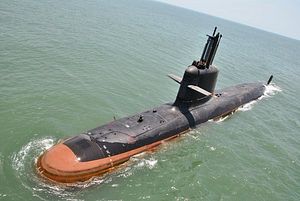The Indian Navy’s first indigenously constructed, diesel-electric Scorpene-class attack submarine entered its first sea trials on Sunday. The INS Kalvari, the first of six planned Indian Scorpene submarines, entered sea trials out of Mumbai Harbor, according to the Indian Express.
INS Kalvari is expected to see commissioning either later this year or early next year after several delays. Though the Kalvari began its first open sea trials over the weekend, it had been set afloat in October 2015, as Franz-Stefan Gady discussed in The Diplomat.
The Scorpene is a joint Franco-Spanish submarine design, built today by France’s DCNS consortium. With a hull length of 67 meters and submerged displacement of approximately 2,000 tons, the submarines will fulfill several important missions for the Indian Navy, including anti-surface ship and anti-submarine warfare, intelligence gathering, and surveillance.
India’s Scorpenes will be armed with SM-39 Exocet missiles, a sea-skimming, solid fueled, anti-ship missile with an operational range up to 180 kilometers and terminal active radar homing.
Italian firm WASS Italy, a subsidiary of Finmeccania, had been awarded the bid to provide heavy torpedoes for India’s new attack submarine, but its involvement has been frozen amid another Finmeccania company’s alleged involvement in the VVIP helicopter scandal. Anglo-American firm AgustaWestland was accused of bribing senior Indian government officials to win a $530 million 12-helicopter contract.
The Indian Navy has plans to build six Scorpene submarines, with a potential for two additional submarines after the first six are delivered. The submarines are being license-built at Mazagon Dock, a government-run shipyard at Mumbai.
The Indian Navy chose to go with the Scorpene design for its new diesel-electric submarines under the $3 billion Project 75 tender. The submarines will replace the Indian Navy’s aging Sindhughosh-class and Shishumar-class attack submarines, which are based on Russia’s Kilo-class and Germany’s Type 209/1500 submarine designs respectively.
In 2014, India’s Chief of Naval Staff Admiral DK Joshi resigned after two serious accidents involving Indian submarines. In 2013, an Indian Sindhughosh-class submarine, the INS Sindhurakshak, encountered a major fire and sank.
Shortly thereafter, in early 2014, INS Sindhuratna, another Sindhughosh-class submarine, had its interior filled with smoke, resulting in 5 sailors falling unconscious.
Despite challenges facing India’s submarine program, the pending arrival of Scorpene-class boats combined with the simultaneous development of India’s indiegnous Arihant-class of nuclear-powered, ballistic missile submarines (SSBNs), India’s undersea capabilities are slated to improve.

































